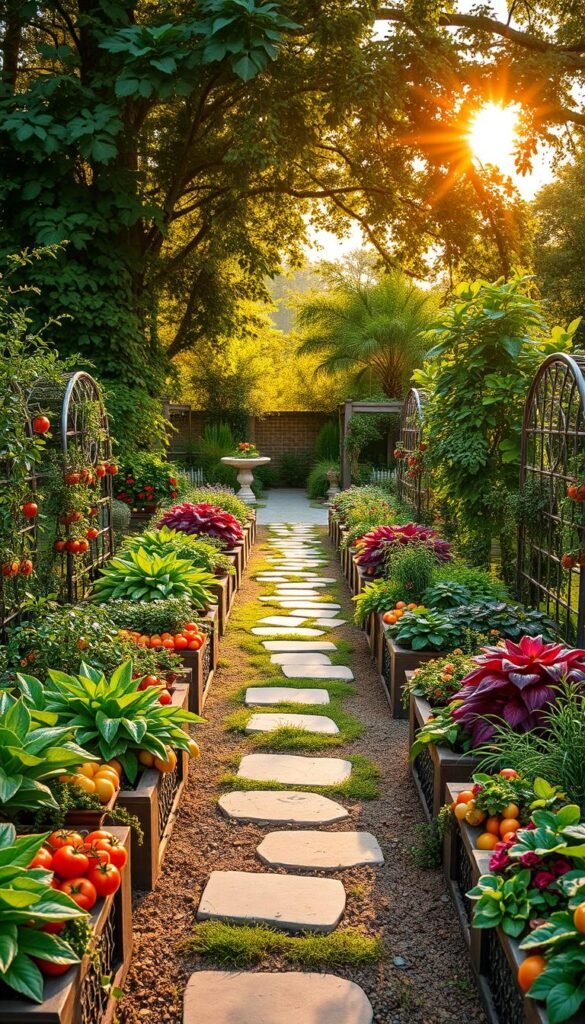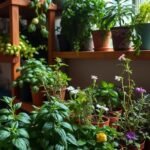Your outdoor space can be both productive and visually stunning. Gone are the days when growing food meant sacrificing beauty—today’s approach blends practicality with creativity. Imagine plucking ripe tomatoes beside fragrant blooms or winding through orderly beds framed by charming borders. This harmony is within reach, even in compact yards.
Thoughtful design transforms ordinary plots into inviting retreats. Vertical structures like trellises add height and drama, while pathways guide the eye and simplify maintenance. Borders define spaces, creating a polished look that elevates your entire landscape. These elements work together to turn a basic growing area into a dynamic, layered sanctuary.
You don’t need professional skills or endless budgets to achieve this balance. Simple swaps—like using repurposed materials for raised beds or mixing edible plants with ornamentals—make a big impact. The result? A space that feeds your family and sparks joy every time you step outside.
Ready to reimagine your plot? Let’s explore how strategic choices in layout, materials, and plant pairings can create a haven that’s as nourishing to the spirit as it is to the table.
Getting Started with Your Vegetable Garden Vision
Every thriving green space begins with intention. Whether you’re growing snacks or creating a sanctuary, clarity about your priorities shapes every decision. Start by asking: Do crisp geometric patterns spark joy, or do wildflower-like arrangements feel more authentic? Your answers become the blueprint for a space that works with your lifestyle, not against it.
Defining Your Goals and Style
Formal layouts with symmetrical beds demand regular upkeep, while cottage-inspired designs thrive with casual charm. Match your plant choices to the time you can dedicate weekly—compact herbs need less attention than sprawling squash vines. Borrow colors and textures from your vegetable row spacing strategy to maintain harmony as plants mature.
Embracing the Joy of Gardening
Position key features where you’ll see them often—a basil-lined path visible from your coffee nook or scarlet runner beans climbing near your patio. Progress beats perfection: even seasoned growers learn through trial and error. Celebrate small wins, like your first homegrown salad or a pollinator visiting your blooms. These moments turn routines into rituals.
Planning Garden Pathways and Decorative Borders
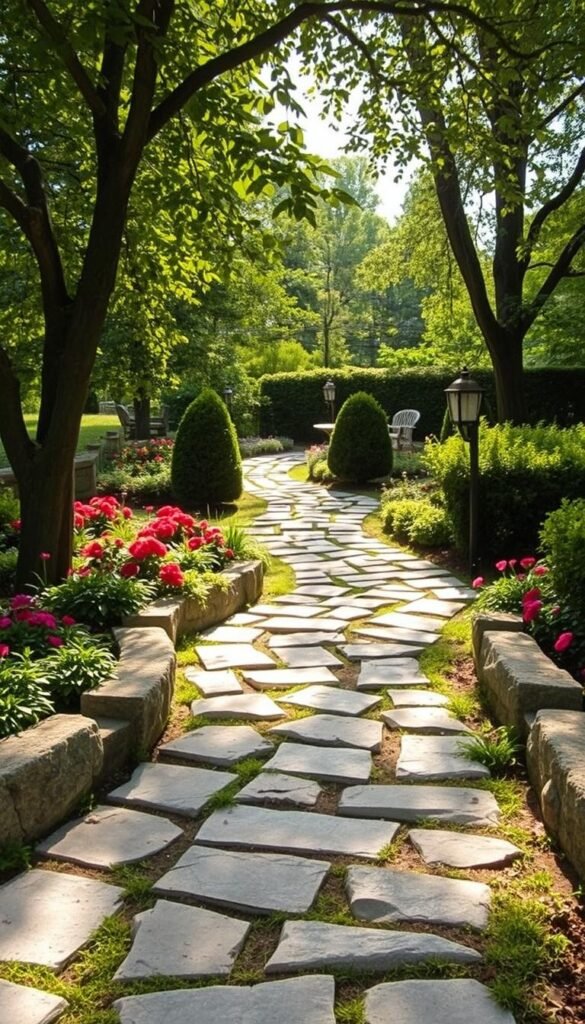
Clear walkways and defined edges transform chaotic plots into organized retreats. Your paths do more than prevent muddy shoes—they shape movement and highlight your plantings. Start by mapping routes between growing zones, keeping widths consistent for easy navigation.
Walkway Materials That Work Hard
Choose surfaces that match your home’s style and local weather. Crushed gravel suits rustic spaces, while geometric pavers add modern flair. Stability matters most—rough-textured stones prevent slips, and wide layouts accommodate wheelbarrows.
| Material | Cost | Durability | Maintenance |
|---|---|---|---|
| Gravel | $ | 5 years | Monthly raking |
| Brick | $$$ | 15+ years | Occasional weeding |
| Flagstone | $$ | 10 years | Annual leveling |
| Wood Chips | $ | 2 years | Bi-yearly refresh |
Borders That Define and Delight
Use low walls or plants to separate growing spaces from walk areas. Stacked slate creates crisp lines, while creeping thyme softens edges. For aesthetic harmony, repeat materials from your pathways in border designs.
Natural Accents with Purpose
Scatter river rocks along bed edges to control weeds and add texture. Tuck chive plants between bricks—their purple blooms pair beautifully with kale. Remember: borders should enhance, not overshadow, your edible stars.
Integrating Trellises for Vertical Appeal
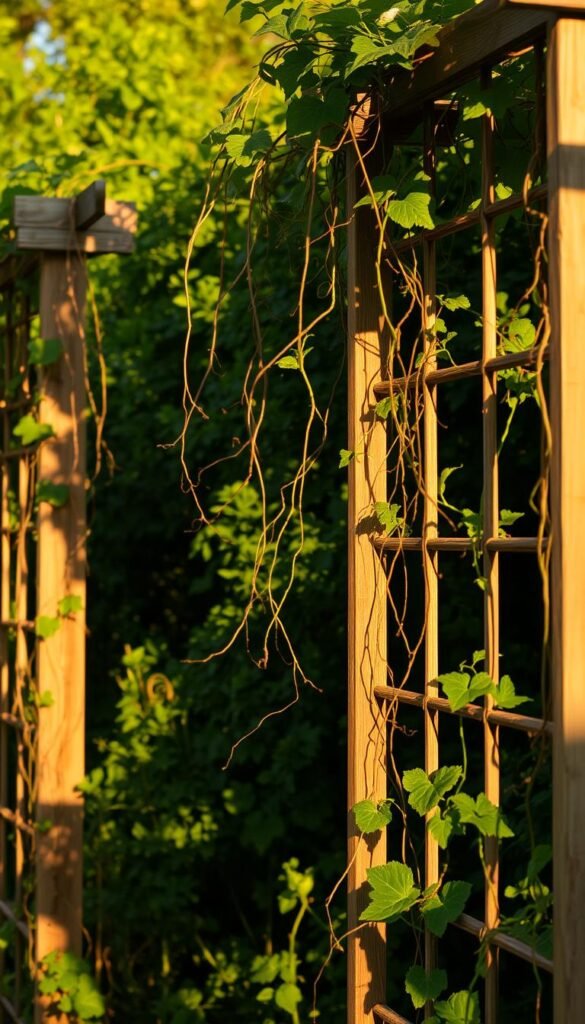
Transform empty air into lush, productive displays. Vertical structures let you grow more in less space while adding architectural interest. A well-chosen support system becomes both functional art and a habitat for thriving climbing plants.
Choosing the Right Trellis Structures
Match your framework to your garden’s personality and your plants’ needs. Delicate sweet peas flourish on lightweight grids, while beefsteak tomatoes demand heavy-duty reinforcement. Consider these popular options:
| Material | Best For | Lifespan |
|---|---|---|
| Bamboo | Peas, beans | 3-5 years |
| Powder-coated steel | Tomatoes, gourds | 10+ years |
| Cedar | Flowering vines | 7-8 years |
| Wire grid | Cucumbers, nasturtiums | 15+ years |
Rotate crops seasonally for continuous visual impact. Early spring? Try sugar snap peas on arched frames. Summer heat calls for cherry tomatoes tumbling over metal obelisks. One gardener’s secret:
“Paint supports black—they disappear behind green leaves but shine in winter.”
Position structures where they’ll cast afternoon shade on lettuce or spinach. This dual-purpose approach keeps tender greens cool while showcasing your vines at golden hour. Remember: sturdy anchors prevent wind damage during storms!
Pretty Vegetable Garden Ideas: Styling Trellises, Pathways, and Borders
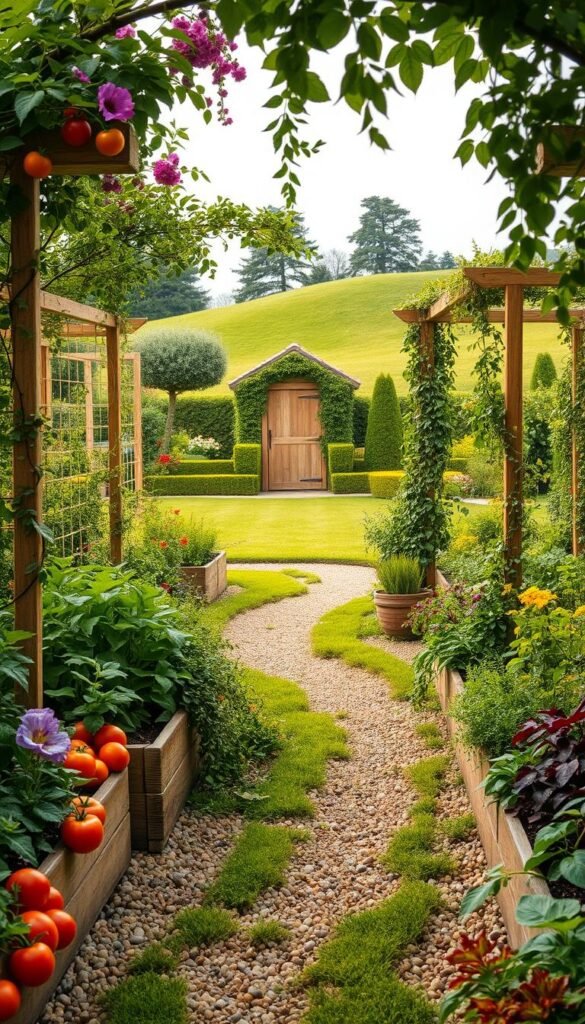
Smart layouts turn practical spaces into living art. Start by swapping traditional rows for structured garden beds and pathways that define your growing zones. These elements become your canvas—where organization meets creativity.
Strategic Bed Placement and Materials
Build permanent raised beds using materials that match your style. Stack stone for rustic charm or use cedar planks for clean lines. Varying heights create terraced levels that improve drainage and add depth.
| Material | Cost | Drainage | Longevity |
|---|---|---|---|
| Lumber | $$ | Good | 5-7 years |
| Stone | $$$ | Excellent | 15+ years |
| Logs | $ | Fair | 3-4 years |
| Soil Mounds | Free | Variable | 1 season |
Flow and Visibility Essentials
Position tall crops on the north side of garden beds to prevent shading. Connect pathways to trellis locations so vining plants become natural landmarks. One gardener notes:
“Winter planning lets me see the bones of my space—I adjust curves and angles before spring growth hides the structure.”
Use matching gravel or mulch in pathways and borders to unify your design. Corner trellises draw eyes upward, making small areas feel expansive. Remember: your layout should work as hard as your plants!
Adding Color and Texture with Mixed Plantings
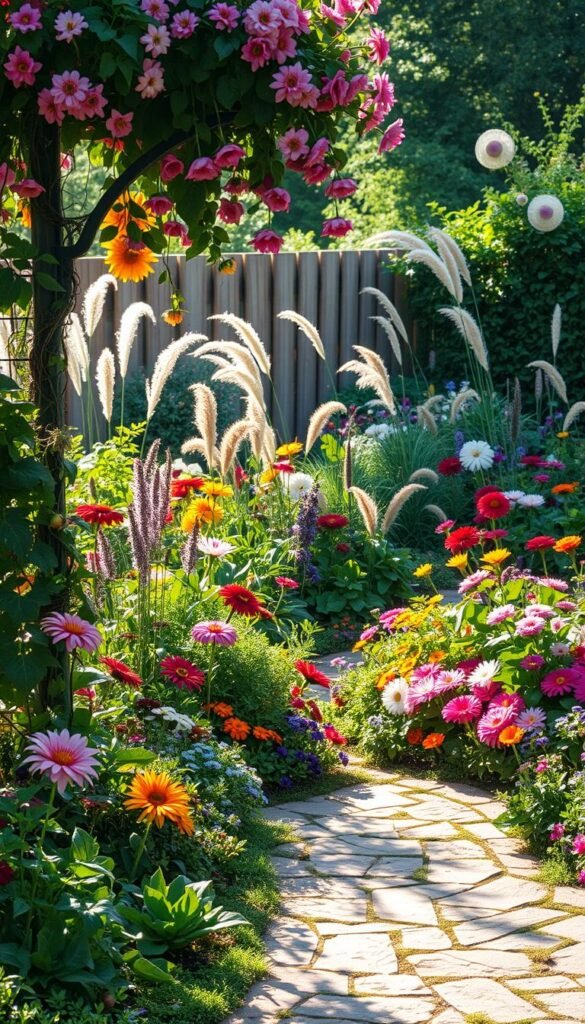
Edible spaces bloom with personality when you blend flowers with functional crops. Strategic pairings create visual depth while supporting plant health. One secret? Treat your beds like living canvases—layer heights, textures, and hues for year-round interest.
Pairing Vegetables with Vibrant Flowers
Zinnias make perfect neighbors for dark-leafed kale, their fiery petals popping against deep greens. Purple salvias mirror eggplant blossoms, creating harmony. Place these showstoppers at bed corners where they frame your plants without blocking access.
Try these winning combinations:
- Sunny marigolds deter pests near tomatoes
- Verbena bonariensis attracts pollinators to squash vines
- Globe amaranth adds structure beside pepper plants
Selecting Unique Vegetable Varieties
Swap standard greens for purple carrots or white eggplants. Rainbow chard’s neon stems dazzle beside blue-flowered basil. Pro tip: Grow yellow tomatoes with indigo nasturtiums—the contrast stops visitors in their tracks.
Seasonal planning keeps colors flowing:
- Spring: Pansies + purple sprouting broccoli
- Summer: Orange zinnias + electric lavender eggplants
- Fall: Rudbeckia + burgundy okra
These pairings do double duty. Bright blooms lure beneficial insects, while unusual veggies become conversation starters. Your space works harder, looks brighter, and tastes better.
Creative Techniques with Raised Beds and Window Boxes
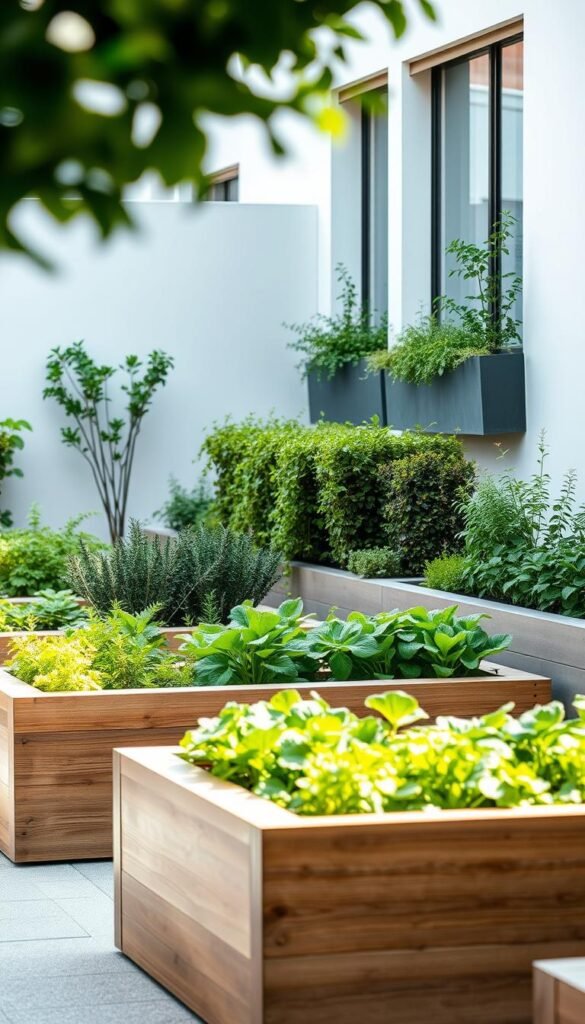
Elevate your growing game with designs that marry form and function. Modern raised beds transform basic plots into sculptural elements, while window boxes bring fresh flavors to your fingertips. These solutions maximize every inch of your space, whether you’re working with sprawling yards or compact urban areas.
DIY Raised Bed Ideas for a Modern Look
Ditch the rectangle! Curved steel beds create flowing lines that complement contemporary homes. Try tiered designs with 12-inch levels for herbs up top and 24-inch depths for carrots below. One gardener shares:
“My L-shaped bed wraps around the patio—it holds tomatoes and serves as extra seating during gatherings.”
Choose materials that age beautifully. Corten steel develops a rustic patina, while composite boards stay splinter-free. For narrow spaces along your house, build 18-inch-wide beds with built-in trellises. They save walkway space while supporting climbing beans.
| Material | Ideal Height | Best Plants |
|---|---|---|
| Composite | 12-18″ | Lettuce, basil |
| Galvanized steel | 24-36″ | Tomatoes, peppers |
| Stacked stone | 16-20″ | Carrots, radishes |
Window boxes make magic happen near kitchen windows. Plant rosemary and thyme in 8-inch-deep containers—their silvery greens pair perfectly with brick exteriors. Use quality soil mix to ensure strong growth without frequent watering. Pro tip: Add drip irrigation lines when building beds to simplify summer care.
Exploring Vertical Solutions for Compact Spaces
Maximize every inch of your outdoor area with vertical solutions that combine beauty and harvests. These smart approaches let you grow abundant crops while creating eye-catching displays—perfect for small yards or urban backyards.
Using Climbing Plants and Arbors
Turn functional supports into showpieces. Wooden arbors draped with scarlet runner beans or dangling squash become living sculptures. Position them near seating areas to create shaded retreats where you can admire their heart-shaped leaves up close.
Try pairing purple hyacinth beans with golden zucchini vines. One gardener shares: “My arbor doubles as a privacy screen—guests never guess it’s covered in edible plants!” Secure heavy fruits with soft cloth slings to prevent damage as they mature.
Vertical Containers and Gutter Gardens
Repurpose everyday items into space-saving planters. Mount recycled gutters along sunny walls for leafy greens—their shallow roots thrive in narrow spaces. Use adjustable hooks to lower containers for easy harvesting.
Mix textures by planting frilly lettuce beside spicy arugula. Stagger plantings every two weeks for continuous harvests. Pro tip: Add drip irrigation lines to vertical setups for fuss-free watering during summer heat.
These vertical strategies prove that limited ground space doesn’t mean limited possibilities. Start with one arbor or a few hanging planters, then expand as your confidence grows. Your yard will soon become a layered paradise where practicality meets creativity.
